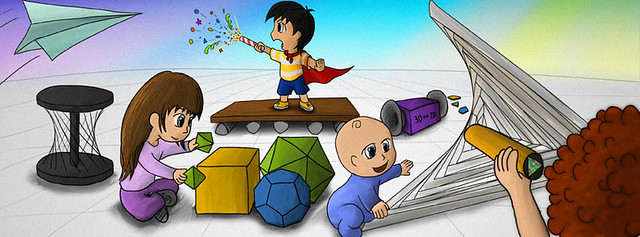Newsletter August 30, 2012

Welcome to adventurous math for the playground crowd! I am Moby Snoodles, and I love to hear from you at moby@moebiusnoodles.com
Moby’s mail
As Sue VanHattum guessed, my native language is Whalish. And now Ever discovers my favorite color is 33 80 DE. Translated from Whalish (hexadecimal, base 16) into human, these are three numbers:
51 128 222
coding red-green-blue parts of a color. You can see there is not much red (51), but a whole lot of blue (222), mixed with about half as much of lovely green (128). The color of endless oceans and evening skies!
The topic of different number bases was made somewhat accessible to young children in the sixties and seventies of the twentieth century. There are already many games and stories about it. The main thing parents need to know is that young kids love small bases. Base 16, which digital artists use, is no good for toddlers, and neither is, sadly, base 10 that most humans use. Little kids need tiny bases – binary (2), ternary (3) or at most base 5. But this is a not a tiny topic – we will explore it on the blog!
– I thought Moby needed some color, hahaha… I hope you like :) – Ever Salazar
– Thank you, Ever. Not just “some” color, but my favorite color! I like! – Moby
Book news
Mathematics is deeply playful. How deeply? It’s fractally playful! It’s playful at every conceivable scale of resolution! Zooming in on any part of any mathematical endeavor finds parts every bit as playful as the whole.
Why is mathematics playful?
How can people who are not mathematicians experience math play?
Both questions have the same answer, which is, in turn, a question: WHAT IF?
If I weren’t a whale and could climb, I would shout “What if?” from the roofs of the tallest buildings, because the world needs more of it. Mathematics is playful because it constantly asks this silly, hilarious, game-like question, “What if?” You can experience math play if you ask this question, a lot. What if you make parallel lines intersect? (Non-Euclidean geometries.) What if you took square roots of negative numbers? (Complex numbers.) What if you divided by zero? (Infinity, which young kids love.)
The chapter we worked on this week is about composition of functions. It uses a lot of animal examples. What if dogs had 8 legs? What if you could reverse time and turn hens into baby chickens? What if you used a spinner instead of a die in your favorite game? Play on!
Our blogs and lapware
Mobius strips

Yelena describes storytelling play involving mobius strips, inspired by the lovely Vi Hart video “Wind and Mr.Ug.” We highly recommend the story and the video to you and your kids!
http://www.youtube.com/watch?v=4mdEsouIXGM
Velocity Raptor
http://www.testtubegames.com/velocityraptor.html
From our Facebook write-up: “Lapware: A game about relativity theory, accessible to young kids. Play past level 4 for cool effects that blow your mind! I am sitting here laughing out loud as the dinosaur makes the room around him stretch in bizarre ways as he runs at near-light speeds. Thank you for the link, Chris Hazard!”
Talk to you again on September 15th!
Moby Snoodles, aka Dr. Maria Droujkova
Related Posts
Posted in Newsletter








Leave a Reply